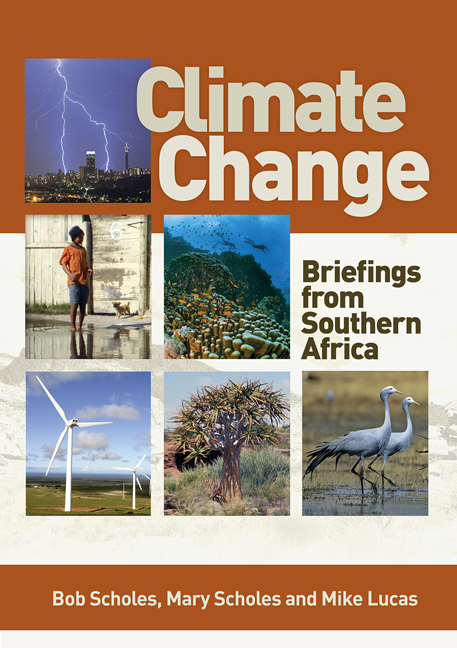Book contents
- Frontmatter
- Acknowledgements
- Contents
- Foreword
- Acronyms and abbreviations
- Preface
- How do governments assess climate change?
- Section 1 Earth system science: The processes that underlie climate change
- Section 2 Consequences of a changing climate for the Southern African environment
- Introduction
- 1 How resilient are ecosystems to climate change?
- 2 How will South Africa's plants respond to climate change?
- 3 Could rising carbon dioxide concentrations boost plant growth?
- 4 Is bush encroachment caused by global change?
- 5 Will South Africa's land animals cope with climate change?
- 6 Are South Africa's birds taking flight?
- 7 Will South Africa run out of water?
- 8 How will climate change affect freshwater ecosystems?
- 9 How much, and how fast, will sea level rise?
- 10 What is ocean acidification?
- 11 How will ocean acidification affect marine organisms?
- 12 How is climate change affecting South Africa's coastal seas?
- 13 How is our marine life responding to climate change?
- 14 Will coral reefs survive climate change?
- 15 Are South Africa's Prince Edward Islands vulnerable to climate change?
- 16 How are Antarctica and the Southern Ocean responding to climate change?
- Section 3 Consequences of a changing climate for society
- Section 4 What we can do to avoid and adapt to climate change
- Codicil Is there a dangerous level of climate change?
- Glossary
- List of figures
- References
- Reading list
- Index
4 - Is bush encroachment caused by global change?
from Section 2 - Consequences of a changing climate for the Southern African environment
Published online by Cambridge University Press: 20 April 2018
- Frontmatter
- Acknowledgements
- Contents
- Foreword
- Acronyms and abbreviations
- Preface
- How do governments assess climate change?
- Section 1 Earth system science: The processes that underlie climate change
- Section 2 Consequences of a changing climate for the Southern African environment
- Introduction
- 1 How resilient are ecosystems to climate change?
- 2 How will South Africa's plants respond to climate change?
- 3 Could rising carbon dioxide concentrations boost plant growth?
- 4 Is bush encroachment caused by global change?
- 5 Will South Africa's land animals cope with climate change?
- 6 Are South Africa's birds taking flight?
- 7 Will South Africa run out of water?
- 8 How will climate change affect freshwater ecosystems?
- 9 How much, and how fast, will sea level rise?
- 10 What is ocean acidification?
- 11 How will ocean acidification affect marine organisms?
- 12 How is climate change affecting South Africa's coastal seas?
- 13 How is our marine life responding to climate change?
- 14 Will coral reefs survive climate change?
- 15 Are South Africa's Prince Edward Islands vulnerable to climate change?
- 16 How are Antarctica and the Southern Ocean responding to climate change?
- Section 3 Consequences of a changing climate for society
- Section 4 What we can do to avoid and adapt to climate change
- Codicil Is there a dangerous level of climate change?
- Glossary
- List of figures
- References
- Reading list
- Index
Summary
Rising carbon dioxide (CO2) concentration in the atmosphere probably contributes to the observed increase in woody cover in savannas and the invasion of trees into grasslands, but it is unlikely to be the sole cause. Historical and current changes in grazing by wildlife and domestic livestock have also played a role in bush encroachment, as have changes in the fire regime.
When European settlers began raising cattle in South Africa around 100 years ago in open grassy landscapes with few trees, they found that the density of woody plants suddenly increased. Historical photographs show that areas now covered in bush were once grassland areas largely devoid of trees. This phenomenon, called bush encroachment in South Africa, has also been observed in Australia, Texas, Argentina and many other places. It is a big problem for cattle farmers because trees compete with grass, reducing the feed available for cattle and other grazers. Up to a fifth of the land in South Africa (12–20 million hectares) is thought to be affected by bush encroachment. Bush encroachment has historically been blamed on sustained heavy grazing in fenced-offareas, which disadvantages grass relative to trees. Sharp contrasts, easily observable across fence lines, show that some farms (or camps within farms) are more affected than others. Therefore, the direct cause of bush encroachment must be related to land management rather than climate or atmosphere, which pay no heed to fences. However, it is likely that atmospheric and climatic change are contributing or predisposing factors to bush encroachment.
Periodic natural fires used to keep the trees in check. When most of the grass, the main fuel for fire, is eaten by herbivores, hot, frequent fires are not possible. The formerly suppressed tree seedlings are then able to shoot up, out of the range of grazers and flames, and come to dominate the grasses. This further suppresses grass growth and the ecosystem becomes stuck in a bush-encroached state. Ranchers frequently extinguish natural fires to preserve their grazing, and have added to the problem by hunting out browsers such as kudu, giraffe and elephants that formerly ate the trees. It is speculated that, in the pre-colonial era, indigenous grazers and the cattle maintained by pastoralists did not lead to bush encroachment because the herds were migratory and fires were not controlled.
- Type
- Chapter
- Information
- Climate ChangeBriefings from Southern Africa, pp. 63 - 65Publisher: Wits University PressPrint publication year: 2015



